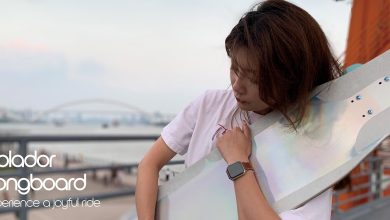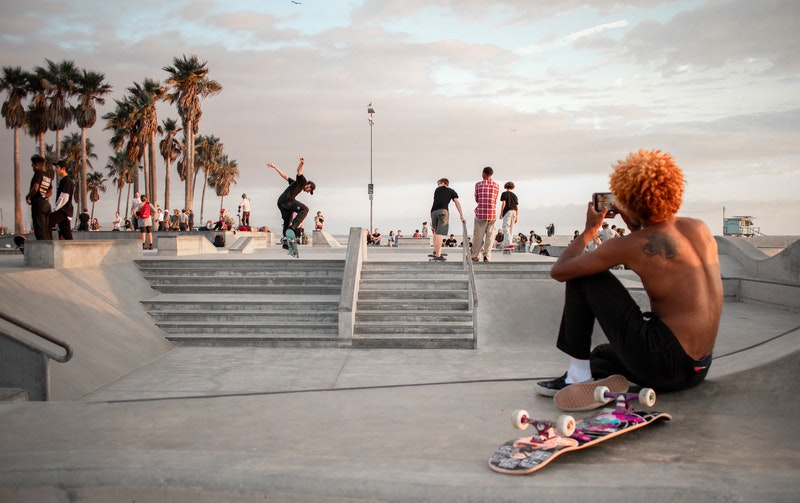Introduction
Contrary to popular belief, not every board with 4 wheels is called a skateboard. Should you browse online or visit a skate shop, you can find a wide variety of longboards and cruisers.
These terms might sound confusing for beginners. So longboard vs cruiser: what’s the difference?
That is why we provide you with a complete guide on the main differences between the two boards.
This article will analyze how they are defined, the design, the skateboard styles, and when they would show their ability the most.
Definition
Before we start, let’s take a look at the definitions and how each type of skateboard works.
Longboard
Compared to traditional skateboards, longboards are longer and come in multiple shapes such as swallowtails, pintails, flat-nose, and drop decks. Overall, longboards are relatively faster due to having larger wheels and an aerodynamic design.
Cruiser
On the other hand, cruiser boards are typically shorter, with smaller wheels, decks, and trucks.
The modest size makes them more portable and lightweight. As a result, they take up minimal space and are extremely comfortable to carry around.
Cruisers, similar to longboards, can have a plethora of sub-categories. Assuming you have not known which cruiser board would fit you best, here’s some information on the different types you’ll likely encounter in stores:
- Mini cruisers: The smallest of all cruisers – great for young children to learn to skate or those looking for a weightless board.
- Cruiser: The standard board is generally comfortable for children and adults alike. It offers every feature you would need to ride around town at Mach 5 speed!
- Penny boards: These plastic mini boards are the cheapest. They have a great turning range and a narrow deck, allowing you to fit through small gaps comfortably.
Design
This is where longboards and cruisers differ the most, from the exterior to the interior. We highly suggest you read carefully, as these details determine how well the boards will meet your needs.
Dimensions
Although more and more skateboards are breaking the mold, longboards and cruisers will work best if they are built according to these specifications.
Longboard
Boards’ lengths are usually between 33 and 59 inches whereas their widths range from 9 to 10 inches. The form of a longboard varies from different designs depending on the players’ favorites like the flat-nosed, pintails, and the exclusive drop-through.
Among numerous designs, skaters prefer pintail, drop deck and drop through for their great advantages.
Pintails allow skaters to go with both roomy trucks and bigger wheels. They are beneficial for those wanting better carves or a flatter feel.
Drop-through boards let the rider get nearer to the ground easily. Technically speaking, this design supports riders with a lower midpoint to increase stability for faster speedboarding.
For medium-sized boards, those between 37 inches and 50 inches are the top picks as they can support riders with different skating needs.
Cruiser
A cruiser is smaller than a conventional skateboard, with its length falling anywhere between 28-32 inches and the width is less than 8.5 inches.
Components
Construction is another obvious difference between a longboard and a cruiser.:
Decks
As the name suggests, longboards have lengthy decks, which contribute to their superior stability. They also come in different shapes and forms, from the standard oval decks to streamlined designs. Such vast choices are to ensure anyone can easily gain control over the board.
The same goes with cruisers. They specialize in cruising around the suburban streets. Thanks to the modest size deck, skaters can slip through alleys and crowded pathways with relative ease.
One more point worth noting is cruiser boards always come with a kicktail, which lets you quickly stop and make sharp turns around tight corners without risking a fall.
In summary, longboards struggle to be as agile as a cruiser because of their bulky size.
Trucks
It is common to find cruisers running the traditional kingpin trucks (TKP), which is the standard for street boards. These trucks are responsive to the slightest change in your motions, making them perfect for trolling around.
Furthermore, they are quite short, reducing the distance between the deck with the ground. Many users argue that this type of truck has little effect. However, it is what helps to sharpen your “dive”, maintaining your speed over time without delay.
On the flip side, longboards utilize special reverse trucks (RKP). Besides the bulk up base, RKP trucks are essential for a longboard to be stable at increasing speed.
They are heavier and respond slower to your turns for proper balancing. Thus, it may feel harder to turn on longboards, requiring you to master balancing techniques.
Truck Mounts
Trucks are the heart of a skateboard, but did you know that how they are installed on the deck also affects its performance?
Most mini-boards have top mount trucks, meaning they are positioned far from the deck. This means cruisers are relatively close to the ground, making them easier to gain momentum from pushes.
The only downside of these mounts is their flexibility. Top mounts can bend too much during turns, reducing your stability, especially at high speed.
A full-size longboard is more adaptive. Trucks can be top mount like cruisers (pintail longboard) for speed or connect to the deck through holes for better balance.
Wheels
As cruisers are for hasty dashes, they often stick with small wheels, which can be anywhere between 2.2 inches and 2.6 inches. This is not a problem since the deck is scaled down to match the wheel size.
A smaller-than-average wheels set also contributes less weight to the cruisers. Keep in mind that they are bigger than those traditional street boards.
However, wheel size is not the main difference. Most importantly, the wheels on cruisers are softer. Soft, elastic wheels are proficient at absorbing impacts and tackling rough surfaces. They also deliver more traction.
On the other hand, stiffer wheels absorb less friction, especially on smooth surfaces, and slide faster.
We see that wheels on a standard longboard are considerably larger, usually at 2.8 inches. They can go as high as 3.3 inches, which is usually found in beefy 40-inch boards or those with custom decks.
Larger wheels are synonymous with better control, which is one of the reasons why longboards are recommended for longer runs. One similarity of these skateboards is the soft wheels for exceptional cushioning on harsh terrains.
Riding Styles
Regardless of your level, you probably want to know how longboards and cruisers perform in terms of riding experiences.
Cruising
The original purpose of any board is for riding at a casual pace, and longboards are particularly good for transportation. They offer a relaxing riding experience at low speed and steady control. Longboards are a must-have for beginners.
In contrast, a cruiser’s strong point is in its fast speed and nimbleness in short distances. This level of quickness enables riders to effortlessly navigate through town, slide around people and obstacles on busy sidewalks.
Additionally, the cruiser is lightweight and easy to bring along on your road trips. Speed lovers are sure to have one for daily use.
Carving
Carving means making quick S-shape turns with your board. This technique is why cruiser boards are such a popular choice for enthusiasts.
To do it efficiently, you will need a skateboard with a short deck and traditional trucks, components found exactly in cruisers. Through some practice, you can make swift whirls at high speed or high level, sharp 90-degree turns.
Downhill
Longboards have their own set of techniques as well, with the most popular being speedboarding. It revolves around traversing down steep hills as fast as you can. At such a high speed, having a longboard is perfect due to its unparalleled stability.
Capability To Do Tricks
Generally speaking, you can perform stunts on any type of board, as long as you have the necessary skills. But be informed that some tricks are easier to do if you have a suitable skateboard.
Here are some details that would make longboards better at certain moves than the cruisers, and vice versa
Cruiser
The trucks and deck aren’t meant for grinding curbs or ollies, so don’t expect to do so with these boards. Some cruisers have built-in wheel wells, while others have larger paddings to reduce the odds of getting a wheel bite.
Longboard
Longboards with kick tails can be used for freestyle or dancing feats. On a longboard, though, you will not be able to perform the same tricks as you would a cruiser. Professionals recommend basic stepping tricks for starters rather than those over-the-top kicks and flips.
Beware that a larger board means a harder fall. so unless you are an experienced skateboarder, it is best to use the board for transportation around the city.
When Should You Use?
There is no skateboard for every situation. Longboards and cruisers are made for different groups of riders. Though you may like one’s look over the other, choosing the right board for your specific needs will guarantee you full satisfaction.
Longboard
A longboard is what you should look for if you want to travel long distances with little effort. We wouldn’t suggest using them in residential areas or crowded places because they are more difficult to slow down than a cruiser with kicktails.
Steep hills are great to ride on with your longboard. You will enjoy the increased speed and better control with little effort.
Cruiser
As we have mentioned, cruisers are meant for short commutes. If you live in an area with hills and slopes, you should slow down.
Their stability diminishes as you speed up because of the top-mount trucks and small wheels. At a high speed, your cruiser can become hard to control and start wobbling.
Cruisers are incredibly compact and ideal for frequent commuting. Want to catch a bus during your run? You will have no problem holding on to it. Some boards are small enough to store inside your backpack.
For students who want a budget vehicle, choose a cruiser! You can find quality boards at an affordable price. Trust me! Their maneuverability will be a major helping hand on your way to school.
Frequently Asked Questions
We have stumbled upon many questions from users who are also finding the differences between these boards.
Which Is Better, A Longboard Or Cruiser?
From our personal experience, we believe that a longboard sounds more attractive to beginners for many reasons.
It is more stable. This instills more confidence in you, allowing you to reinforce your determination and willingness to learn more about skating.
Plus, you won’t be able to truly commute in the city unless you’ve mastered skating. It would be risky to get into a modest cruiser for training, considering how unpredictable it is.
Last but not least, you will be able to try out several riding styles before determining which trick you want to concentrate on. You will not manage to do much other than drift around with a cruiser.
Overall, we suggest longboards due to their adaptability and ease of use. Starters can get used to it with a lower risk of accidents, and avid riders can make many dynamic tricks.
On the flip side, if you prefer casual strolls to complex trick shots, a cruiser is what you are looking for. They are fast and flexible, allowing you to dash through pathways and access tight alleys other large boards cannot.
How Much Should I Pay For A Longboard?
While you may get one for as little as $50, you’ll probably regret it in no time because of its low quality.
Furthermore, purchasing a low-cost longboard skateboard may prevent you from participating in active activities because low-cost longboards are notorious for providing terrible riding experiences.
Generally, longboards of decent quality range in price from $150 to $450 for the complete set. If you’re a beginner, though, it’s usually better to start with ones that cost between $60 and $250.
How Much Should I Pay For A Cruiser?
If you want a portable cruiser for city riding, expect to pay anywhere between $130 – $150 for a decent board. Mini-cruisers are compact and highly maneuverable, and the best ones have durable trucks and smaller yet more efficient wheels.
Unless you’re serious about the sport and want something premium and highly durable to serve you for the long run, you shouldn’t spend more than $250 on your first cruise board.
Which Board Is Best For Cruising?
Both longboards and cruisers can deliver a satisfying cruising experience. You only need to pick one base on how far you’re intending to go.
For traveling short distances, a cruiser board is a way to go. They are highly maneuverable and are ideal for roaming streets. They are longer than a conventional board but narrower than a longboard.
Longboards are great options for a long, relaxing ride. They feature bigger and wider wheels, giving them more balance over greater distances and uneven grounds.
Are Cruisers Faster Than Longboards?
The cruiser board will always be faster than the longboard in terms of speed. Since the cruise’s deck is shorter than that of a longboard, there is far more room for you to paddle. It is easy to position yourself in an aerodynamic position on the board for even more momentum.
Is Longboard Or Cruiser Safer?
Whether you are riding on a cruiser or a longboard, it is the same in terms of danger. If we take what the boards are built for to compare, sliding down hills is far more dangerous than skating around parks.
Besides, longboards are known for how fast they pick up momentum, reaching a massive 25-31 miles per hour. This is extremely dangerous for people who are getting used to skating and do not know how to break correctly.
In our opinion, cruisers are a safer pick because their build does not encourage stunt moves, but only for casual rides.
See more: Kryptonics skateboard reviews
Conclusion
So, longboard vs cruiser: what’s the difference? And how do you choose between the two? The simplest answer would be, a cruiser is ideal for short-distance rides in tight or crowded places.
It’s compact, light, and portable, so you can take it with you everywhere you go. Unfortunately, the lack of stability makes it not a reliable choice for long-distance travel or speed riding.
For pushing long distances and riding downhill at high speeds, a longboard is more stable and comfortable. It has a significantly broader turning radius than a cruiser, but it’s also longer, heavier, and more difficult to carry as a result.
Depending on the tricks you do, both cruisers and longboards can be utilized for freestyle. Bowling is possible on some cruisers, whereas stepping techniques and dancing are best done on longer boards with kicks.




